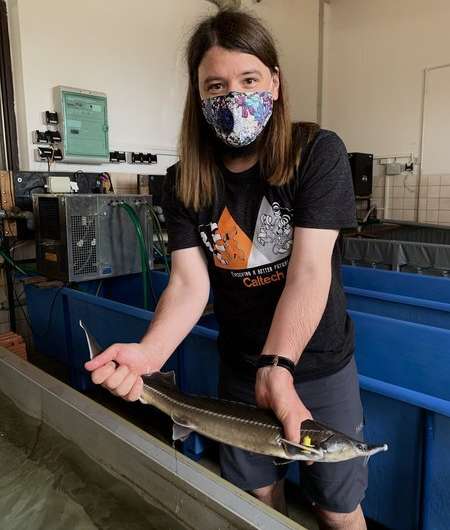Around 350 million years ago, our evolutionary ancestors, along with all modern vertebrates, were soft-bodied organisms living in the oceans. In order to survive and evolve into what we are today, these animals needed to develop some form of protection against the predators that dominated the oceans at that time, primarily crustaceans.
The evolution of dermal armor, such as the sharp spines on an armored catfish or the bony, diamond-shaped scales known as scutes on a sturgeon, proved to be a successful strategy. Various species of fish developed different patterns of dermal armor, composed of bone and/or dentine, a substance also found in human teeth. This protective coating enabled vertebrates to survive and further evolve into new species, eventually leading to the existence of humans.
But how did this armor originate? How did our ancient underwater ancestors develop this protective coat?
A recent study using sturgeon fish has shed light on the development of bony scutes in fish. The research, conducted by Jan Stundl, a postdoctoral scholar in the laboratory of Marianne Bronner at Caltech, found that a specific population of stem cells, known as trunk neural crest cells, is responsible for the formation of bony scutes in fish. This study, published in the journal Proceedings of the National Academy of Sciences, provides insights into the evolution of dermal armor in vertebrates.
The study focused on trunk neural crest cells, which are found in all vertebrates, including fish. These cells become specialized based on their origin in either the head or spinal cord regions. They migrate throughout the developing body of the animal, giving rise to important structures such as the jaws and heart.
A previous study from the University of Cambridge in 2017 demonstrated that trunk neural crest cells are involved in the formation of dentine-based dermal armor in a type of fish called the little skate. Building on this finding, Stundl and his colleagues hypothesized that the same population of cells might also contribute to the development of bone-based armor in vertebrates more broadly.
To investigate this hypothesis, the team studied sturgeon fish, particularly the sterlet sturgeon. These fish have many characteristics similar to their ancestors from millions of years ago, making them ideal subjects for evolutionary studies.

Using sturgeon embryos, the team tracked the migration of trunk neural crest cells throughout the developing body of the fish. The formation of bony scutes in sturgeons begins after a couple of weeks, so the researchers kept the growing fish in a darkened lab to avoid disturbing the fluorescence dye used to track the cells.
The team discovered that the fluorescently labeled trunk neural crest cells were present in the exact locations where the sturgeon’s bony scutes were forming. They also identified genetic signatures associated with the formation of bone in these fluorescent cells, providing strong evidence that trunk neural crest cells give rise to bone-forming cells.
This research, combined with previous findings related to dentine-based armor, confirms that trunk neural crest cells play a crucial role in the development of bony dermal armor in fish. The understanding of these evolutionary processes contributes to our knowledge of developmental biology and sheds light on the small alterations in embryonic development that led to the diversity of cell types found in vertebrates.
Jan Stundl expressed the challenges of working with non-model organisms but highlighted the valuable insights gained from studying species like the sturgeon. Marianne Bronner emphasized the power of approaching evolutionary questions from a developmental biology perspective, allowing researchers to infer past evolutionary events through the study of different animals on the tree of life.
The research article is titled “Ancient vertebrate dermal armor evolved from trunk neural crest.”
More information: Jan Stundl et al, Ancient vertebrate dermal armor evolved from trunk neural crest, Proceedings of the National Academy of Sciences (2023). DOI: 10.1073/pnas.2221120120
Provided by California Institute of Technology
Citation: How fish evolved their bony, scaly armor (2023, July 17) retrieved 17 July 2023 from https://phys.org/news/2023-07-fish-evolved-bony-scaly-armor.html
This document is subject to copyright. Apart from any fair dealing for the purpose of private study or research, no part may be reproduced without the written permission. The content is provided for information purposes only.
Denial of responsibility! TechCodex is an automatic aggregator of the all world’s media. In each content, the hyperlink to the primary source is specified. All trademarks belong to their rightful owners, and all materials to their authors. For any complaint, please reach us at – [email protected]. We will take necessary action within 24 hours.

Jessica Irvine is a tech enthusiast specializing in gadgets. From smart home devices to cutting-edge electronics, Jessica explores the world of consumer tech, offering readers comprehensive reviews, hands-on experiences, and expert insights into the coolest and most innovative gadgets on the market.

